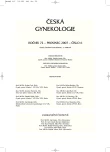Results of Conservative Non-Pharmacological Therapy in Female Patients with Urinary Incontinence
Výsledky konzervativní nefarmakologické terapie u pacientek s močovou inkontinencí
Úvod:
Inkontinence moči patří k nejčastějším zdravotním problémům zejména ženské populace, kterým trpí v celosvětovém měřítku stamiliony lidí. Není sice spojena s vysokou morbiditou či mortalitou, má však zásadní vliv na kvalitu života postižených pacientů.
Práce hodnotí subjektivní a objektivní výsledky konzervativní nefarmakologické terapie a její vliv na kvalitu života v souboru pacientek s močovou inkontinencí všech typů.
Materiál a metody:
Do souboru bylo zahrnuto celkem 69 pacientek s močovou inkontinencí léčených konzervativní nefarmakologickou terapií. Zařazeny byly pacientky se všemi typy inkontinence (stresová inkontinence, urgentní inkontinence, smíšená inkontinence) I.-II. stupně závažnosti. Průměrný věk souboru byl 55 (19-80) let.
Všechny pacientky byly léčeny komplexně podle principů tzv. ostravského konceptu konzervativní nefarmakologické terapie.
Subjektivní výsledky jsme hodnotili pomocí vizuálně-analogové škály (VAS), objektivní výsledky jsme hodnotili perineometrickým měřením svalů pánevního dna a kvalitu života jsme hodnotili pomocí dotazníku I-QoL. Hodnocení bylo provedeno před zahájením terapie a po 6 měsících.
Výsledky:
Před léčbou byla hodnota na VAS 5,82, po léčbě byla hodnota na VAS 2,73. Hodnota indexu kvality života před léčbou byla v našem souboru 55,6 (13,6 – 92,7), po léčbě 72,6 (22,7 – 98,7).
Hodnota maximální síly kontrakce svalů pánevního dna před léčbou byla 16,9 (5–51) cm H₂O, po léčbě byla 17,4 (5–37) cm H₂O, střední hodnota síly kontrakce svalů pánevního dna před léčbou byla 10,8 (6–39) cm H₂O, po léčbě byla 12,8 (3–33) cm H₂O, průměrná doba trvání maximální kontrakce svalů pánevního dna před léčbou byla 5,5 (1–16) s, po léčbě byla 9,1 (1–19) s.
Závěr:
Na základě dosažených výsledků hodnotíme konzervativní nefarmakologickou terapii jako účinnou metodu léčby u I. a II. stupně inkontinence. Vzhledem k její neinvazivitě a absenci nežádoucích účinků by měla být považována za léčbu první volby u pacientek s inkontinencí moči.
Klíčová slova:
stresová inkontinence, hyperaktivní měchýř, kvalita života, svaly pánevního dna, konzervativní terapie, cvičení pánevního dna, mikční tréning
Authors:
J. Krhut 1; R. Holaňová 2; I. Muroňová 2; M. Gärtner 3
Authors‘ workplace:
Urologické oddělení FN Ostrava-Poruba, přednosta MUDr. J. Krhut, Ph. D.
1; Klinika léčebné rehabilitace FN Ostrava-Poruba, přednostka MUDr. I. Chmelová
2; Gynekologicko-porodnická klinika FN Ostrava-Poruba, přednosta MUDr. O. Šimetka
3
Published in:
Ceska Gynekol 2007; 72(6): 406-409
Category:
Original Article
Overview
Introduction:
The urinary incontinence belongs among the most frequent health problems especially in female population. Hundreds millions people suffer from urinary incontinence worldwide. This condition is not associated with a high morbidity or mortality; it influences the quality of life of affected patients however.
The article assesses both subjective and objective results of the conservative non-pharmacological therapy and its effect to the quality of life in the set of female patients with urinary incontinence of all types.
Material and methods:
The set totaled 69 female patients suffering from urinary incontinence treated by conservative non-pharmacological therapy. Patients with all type of incontinence (stress incontinence, urgent incontinence, mixed-type incontinence) of the Ist - IInd seriousness degree were included into the set. The average age of the set was 55 (19-80) years.
All patients were treated in a complex way in accordance with principles of the so-called “Ostrava concept“ of the conservative non-pharmacological therapy.
Subjective results were evaluated using the visual-analog scale (VAS) while objective results were evaluated by the perineometric measurement of the pelvic floor. The quality of life was assessed using the I-QoL questionnaire. The assessment was performed before the therapy started and 6 months after.
Results:
Before the therapy the value at VAS was 5.82, after the therapy the value at VAS was 2.73. The index of the quality of life in our set before the treatment was 55.6 (13.6 – 92.7), after the treatment it was 72.6 (22.7 – 98.7).
The value of the maximum contraction force of the pelvic floor muscles before the treatment was 16.9 (5–51) cm H₂O, after the treatment it was 17.4 (5–37) cm H₂O, the mean value of the contraction force of the pelvic floor muscles before treatment was 10.8 (6–39) cm H₂O, after the treatment it was 12.8 (3–33) cm H₂O, average persistence time of the maximum contraction of pelvic floor muscles before the therapy was 5.5 (1–16) sec while after the therapy it changed to 9.1 (1–19) sec.
Conclusion:
Based on results obtained the conservative non-pharmacological therapy can be assessed as an efficient treatment method in case of the incontinence of Ist and IInd degree. Due to its non-invasive character and the absence of adverse effects it should be considered to be the first choice treatment in case of female patient with urinary incontinence.
Key words:
stress urinary incontinence, overactive bladder, quality of life, pelvic floor muscles, conservative therapy, pelvic floor exercise, bladder training
Labels
Paediatric gynaecology Gynaecology and obstetrics Reproduction medicineArticle was published in
Czech Gynaecology

2007 Issue 6
Most read in this issue
- Pneumonia in Pregnancy
- How Exact Is the Performance of Mediolateral Episiotomy
- Vaginal Bacteriology in Women with Use of Sanitary Towels and Tampons During Menstruation
- Angiomyxoma of the Vulva – a Case Report
